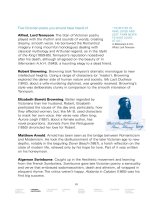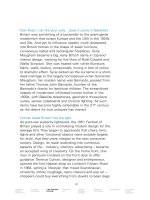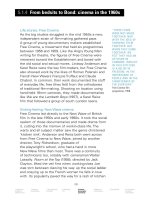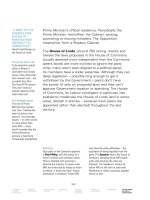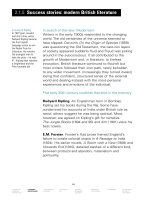Speak the culture britain be fluent in b 93
Bạn đang xem bản rút gọn của tài liệu. Xem và tải ngay bản đầy đủ của tài liệu tại đây (67.59 KB, 1 trang )
Five Victorian poets you should have heard of
Alfred, Lord Tennyson. The titan of Victorian poetry
played with the rhythm and sounds of words, creating
dreamy, smooth verse. He borrowed the Romantics’
imagery in long mournful monologues dealing with
classical mythology and Arthurian legend, as in the Idylls
of the King (1859-85). Tennyson’s reputation nosedived
after his death, although all agreed on the beauty of In
Memoriam A.H.H. (1849), a haunting elegy to a dead friend.
“TI S B ETTER TO
H AV E LO V ED A N D
LO S T, TH A N N EV ER
TO H AV E LO V ED
AT A L L.”
In Memoriam A.H.H.,
Alfred, Lord Tennyson
Robert Browning. Browning took Tennyson’s dramatic monologue to new
intellectual heights. Using a range of characters (or ‘masks’), Browning
explored the darker side of human nature and society. My Last Duchess
(1842), about a wife-murdering diplomat, was greedily received. Browning’s
style was deliberately clunky in comparison to the smooth intonation of
Tennyson.
Elizabeth Barrett Browning. Better regarded by
Victorians than her husband, Robert, Elizabeth
poeticised the issues of the day and, particularly, how
they affected women, but, like Mr B, used characters
to mask her own voice. Her verse was often long;
Aurora Leigh (1857), about a female author, has
novel proportions. Sonnets from the Portuguese
(1850) chronicled her love for Robert.
Matthew Arnold. Arnold has been seen as the bridge between Romanticism
and Modernism. He took the disillusionment of the later Victorian age to new
depths, notably in the beguiling Dover Beach (1867), a harsh reflection on the
state of modern life, relieved only by his hope for love. Part of it was written
on his honeymoon.
Algernon Swinburne. Caught up in the Aesthetic movement and learning
from the French Symbolists, Swinburne gave late Victorian poetry a sensuality
and verve that embraced sadomasochism, death and atheism, all wrapped in
eloquent rhyme. The critics weren’t happy. Atalanta in Calydon (1865) was his
first big success.
83
1. Identity: the
foundations
of British culture
2. Literature
and philosophy
3. Art, architecture
and design
4. Performing
arts
5. Cinema,
photography
and fashion
6. Media and
communications
7. Food and drink
8. Living culture:
the state of
modern Britain

